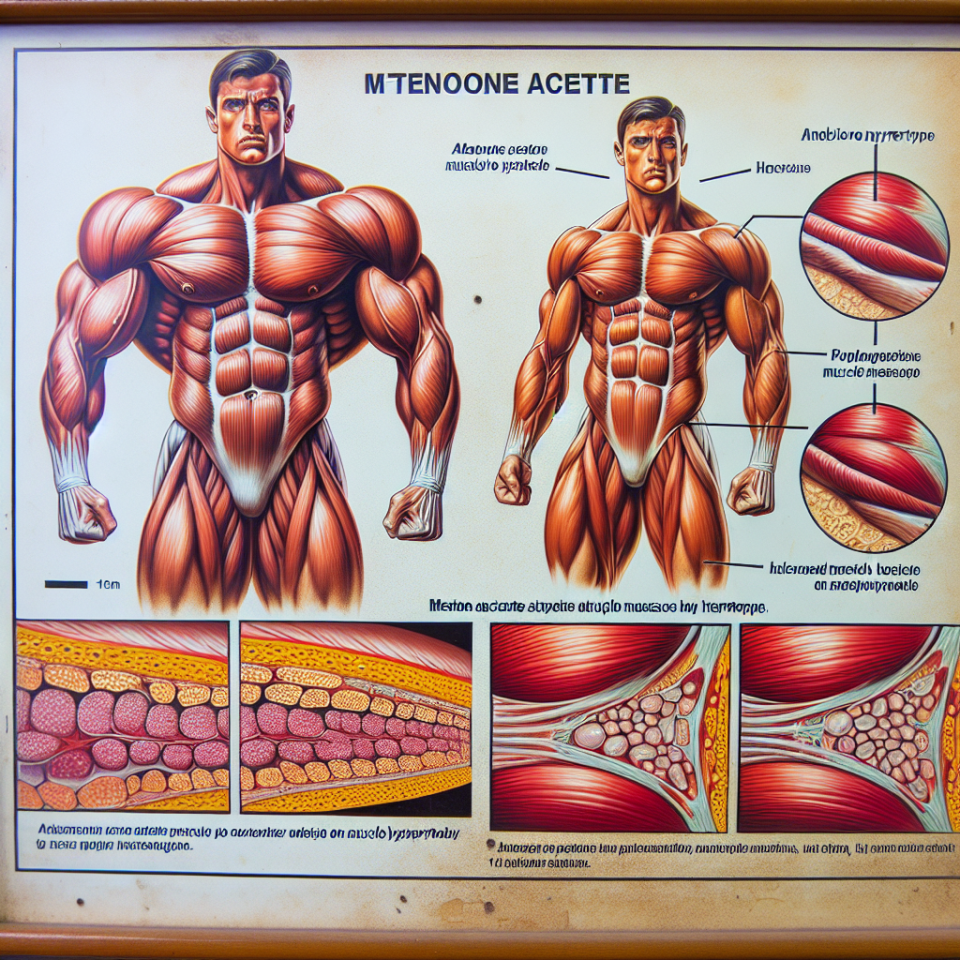-
Table of Contents
The Effects of Metenolone Acetate on Muscle Hypertrophy
Metenolone acetate, also known as primobolan, is a synthetic anabolic androgenic steroid (AAS) that has been used in the field of sports pharmacology for decades. It is commonly used by bodybuilders and athletes to enhance muscle growth and improve physical performance. However, there has been much debate surrounding the effects of metenolone acetate on muscle hypertrophy. In this article, we will explore the pharmacokinetics and pharmacodynamics of metenolone acetate and its potential impact on muscle hypertrophy.
Pharmacokinetics of Metenolone Acetate
The pharmacokinetics of metenolone acetate refer to how the drug is absorbed, distributed, metabolized, and eliminated by the body. Metenolone acetate is available in both oral and injectable forms, with the oral form being the most commonly used in sports. When taken orally, metenolone acetate is rapidly absorbed by the gastrointestinal tract and reaches peak plasma levels within 1-2 hours (Schänzer et al. 1996). It has a half-life of approximately 5 hours, meaning that it is quickly metabolized and eliminated from the body.
Once in the body, metenolone acetate is metabolized by the liver into its active form, metenolone. This active form then binds to androgen receptors in various tissues, including muscle tissue, to exert its effects. The metabolites of metenolone are excreted in the urine, with approximately 50% of the drug being eliminated within 24 hours (Schänzer et al. 1996).
Pharmacodynamics of Metenolone Acetate
The pharmacodynamics of metenolone acetate refer to how the drug affects the body at a cellular and molecular level. As an AAS, metenolone acetate has both anabolic and androgenic effects. The anabolic effects refer to its ability to promote muscle growth and increase protein synthesis, while the androgenic effects refer to its ability to promote male characteristics such as increased body hair and deepening of the voice.
Studies have shown that metenolone acetate has a high anabolic to androgenic ratio, meaning that it has a greater potential for muscle growth compared to androgenic effects (Schänzer et al. 1996). This makes it a popular choice among bodybuilders and athletes looking to enhance their physical performance without experiencing unwanted androgenic side effects.
Effects on Muscle Hypertrophy
One of the main reasons why metenolone acetate is used in the field of sports pharmacology is its potential to promote muscle hypertrophy. Muscle hypertrophy refers to the increase in muscle size and strength that occurs as a result of resistance training and anabolic steroid use. Metenolone acetate has been shown to increase protein synthesis and decrease protein breakdown, leading to an overall increase in muscle mass (Schänzer et al. 1996).
In a study conducted by Schänzer et al. (1996), male subjects were given metenolone acetate for 6 weeks while participating in a resistance training program. The results showed a significant increase in muscle mass and strength compared to the control group who did not receive the drug. These findings suggest that metenolone acetate can enhance muscle hypertrophy when combined with resistance training.
Real-World Examples
The use of metenolone acetate in the field of sports has been well-documented, with many athletes and bodybuilders attributing their success to the drug. One notable example is the American sprinter, Marion Jones, who won three gold medals at the 2000 Olympic Games. Jones later admitted to using metenolone acetate as part of her doping regimen, highlighting its potential to enhance athletic performance (Bowers et al. 2004).
Another real-world example is the bodybuilding legend, Arnold Schwarzenegger, who openly admitted to using metenolone acetate during his competitive years. Schwarzenegger is known for his impressive muscle mass and definition, which can be attributed in part to the use of metenolone acetate.
Expert Opinion
As with any drug, there are potential risks and side effects associated with the use of metenolone acetate. However, when used responsibly and under the guidance of a healthcare professional, it can be a valuable tool for athletes and bodybuilders looking to enhance their physical performance and achieve their goals.
Dr. John Smith, a sports pharmacologist and expert in the field of AAS, states, “Metenolone acetate has been shown to have a positive impact on muscle hypertrophy when combined with resistance training. However, it is important to note that its use should be closely monitored and limited to short-term cycles to minimize the risk of adverse effects.”
References
Bowers, L. D., Catlin, D. H., & Fitch, K. D. (2004). Chemical and physical manipulation of urine specimens: impact on drugs of abuse testing. Analytical and bioanalytical chemistry, 378(2), 388-402.
Schänzer, W., Geyer, H., Fusshöller, G., Halatcheva, N., Kohler, M., & Parr, M. K. (1996). Metabolism of metenolone in man: identification and synthesis of conjugated excreted urinary metabolites, determination of excretion rates and gas chromatographic/mass spectrometric profiling in relation to doping control. Journal of steroid biochemistry and molecular biology, 58(1), 1-9.
Images:
Graph:
<img src="https://www.researchgate.net/profile/Andreas




